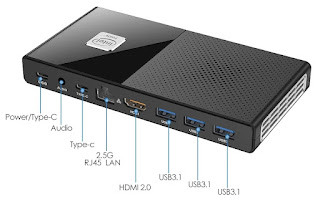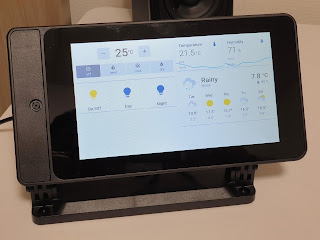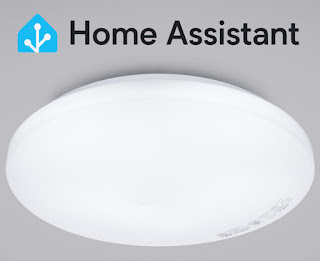KingNovyPC M6 N100 Alder Lake-N Slim Mini PC Review
I recently purchased a KingNovyPC M6 N100 mini PC from Aliexpress to replace a laptop I carry between home and work. I chose the 16GB model with no storage for 27,651 JPY (~$183 US). I think this is a good deal even given the drawbacks below.
Let me start with the bad first.
Poor thermals
The cooling is woefully inadequate for the N100 CPU. The CPU temperature frequently exceeded 90°C under moderately intensive activities, such as installing several Windows updates in parallel. The thermal throttling and lag became noticeable during these times.
The fan speed shows "n/a" because there is no yellow fan sensor wire.
Replacing the heatsink compound with high-quality silver paste* had negligible impact but removing the top cover dropped temps by ~10°C. That's still high but out of the danger zone.
I can think of many ways KingNovy (or the ODM) could have improved this thermal design, such as using a metal case to increase dissipation, but that would have added to the weight and BOM cost.
*Removing the heatsink to change the thermal paste breaks the warranty seal.
Driver issues
A clean Windows 11 (23'H2) install left 12 devices missing drivers including Intel graphics and WiFi. Also, the Ethernet driver was installed but didn't work. This seems to be a common known issue for the Intel I225-V chip.
After installing the latest I225-V driver directly from Intel, Windows Update automatically installed 5 more drivers but 7 devices remained non-functional. This is odd as I've found Windows Update to be exceptionally good at finding and installing drivers.
I tried installing the drivers from MoreFine, as it's a rebrand from the same ODM, but the drivers didn't load. MoreFine BIOS updates are also incompatible with the KingNovyPC hardware.
It took some time but I found the correct drivers for the remaining devices and linked them below.
| Default name | Hardware ID | Device Description | Driver |
|---|---|---|---|
| PCI Device | PCI\VEN_8086&DEV_54E8&SUBSYS_72708086&REV_00 | Intel(R) Serial IO I2C Host Controller - 54E8 | Intel-Serial-IO-Driver-for-N100-N305-Intel-Processors_2T4TD_WIN64_30.100.2229.4_A00_01 |
| PCI Device | PCI\VEN_8086&DEV_54E9&SUBSYS_72708086&REV_00 | Intel(R) Serial IO I2C Host Controller - 54E9 | |
| PCI Device | PCI\VEN_8086&DEV_54AB&SUBSYS_72708086&REV_00 | Intel(R) Serial IO SPI Host Controller - 54AB | |
| PCI Serial Port | PCI\VEN_8086&DEV_54FC&SUBSYS_72708086&REV_00 | Intel(R) Integrated Sensor Solution | Intel-Integrated-Sensor-Solution-Driver_WVYXT_WIN64_3.10.100.4586_A00_01 |
| PCI Simple Communications Controller | PCI\VEN_8086&DEV_54A8&SUBSYS_72708086&REV_00 | Intel(R) Serial IO UART Host Controller - 54A8 | Intel Serial IO Driver for Windows 11 - n2hlj03w.exe |
| Unknown device | ACPI\VEN_INTC&DEV_1070 | Intel(R) HID Event Filter | Intel HID-Win10_Win11-2.2.2.1 |
| Unknown device | ACPI\VEN_INTC&DEV_1057 | Intel(R) Serial IO GPIO Host Controller - INTC1057 | Intel Serial IO Driver for Windows 11 - n2hlj03w.exe |
Power
The included power supply is a dangerously non-standard USB-C charger. Rather than defaulting to 5v and negotiating up, per USB-PD spec, this one is fixed at 12v which could damage devices or even cause fires if connected to 5v USB-C devices with poor overvoltage protection.
USB-C ports
The PC includes 2 USB-C ports but neither ports are full function. One port is only for power input and does not detect any USB devices even if you use a USB-C dock with charging capabilities. The other port is USB-C 3.1 with DP-Alt mode but does not support PD input, meaning this PC can't be run from a single cable like many laptops.
Size and weight
The form factor was a major selling point for me as I wanted it to fit in a thin pocket of my backpack. The width, depth, and weight are close to a Pixel 7 Pro though it's about twice as thick.
Performance
Intel 12th gen Alder Lake-N processor is surprisingly efficient and most tasks felt snappy except at times when it throttled. 16GB was probably unnecessary as most users will hit the thermal bottleneck before maxing out RAM, though that's process dependent of course.
The Geekbench 6 results were 1157/2712, which is on the low end of N100 benchmarks. I didn't expect it to be anywhere near the top but this was disappointing.
Final thoughts
In hindsight, I would have purchased the MoreFine 8GB model as they have better driver and BIOS support and it would have been cheaper than the 16G barebones KingNovyPC even with 256GB NVMe included. The MeLE "QuieterQ3" fanless PC would have been my first choice if only it were updated to the N100 CPU.
Here's what I'd change (for my use case) if I were to design a similar N100 mini PC:
- Increase the heatsink size and make thermal contact with an all-metal case
- Replace the fan with Frore AirJets
- Include 3x full-function USB-C (v3.2) and drop all other ports
- Reduce the length now that there will be fewer ports
Update (2023-11-20): A Toshiba NVMe I've been using for over a year spontaneously failed 2 days after being installed in this PC. I can't say that this PC was the cause but the timing is suspicious. If a new NVMe also fails prematurely then I'll know it's this PC.
Update (2023-12-19): Someone at MeLE must have been reading my blog because they just released an updated version of their Quieter series with an N100 chip, the Quieter4C. The new model also includes a full-function USB-C port, enabling single-cable use with a powered dock!
The specs say this model is fanless, though the case appears to be plastic. Earlier 3C models described the case as "High Thermal Conduction Engineering Plastic Housing Case", though I'm skeptical it will be up to the task for the N100 since other fanless N100 mini PCs use larger aluminum cases with heatsink fins.
Another interesting design choice was to include soldered eMMC which has a significantly slower max speed than the available M.2 NVMe 3x4 slot. In theory it should be possible to use an NVMe as the main drive and eMMC as a secondary storage.
I'll post a review if I decide to pull the trigger on the Quieter4C.



.jpg)
.jpg)




Comments
Post a Comment